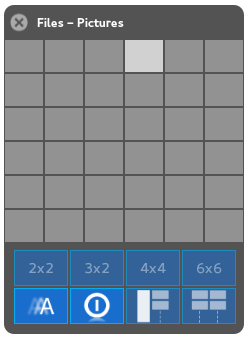Tiling window managers have always interested me, but spending a lot of time tinkering with config files or learning how to wrangle them? Not so much. What I really want is a dead simple way to organize my windows and still use a friendly desktop. And I found it, finally: the gTile extension for GNOME.
If you are using GNOME, pop open Firefox and head to the extension page. Click “on” and go ahead and install the extension.
Once it’s installed, you can click the tile icon in the GNOME menu up top. You’ll see a little overlay with a bunch of squares. The gTile overlay will hover over an open window, and you can click one (or more) of the squares to place the window in that area.
The row of icons that display dimensions (e.g. “2×2”, “4×4”) controls how the screen is tiled. If you just want to divvy up your screen in sixteen equal chunks, choose 4×4. If you have a lot of screen real estate and want many more windows, choose the 6×6. (I’m using gTile with a 4K monitor, and go with 3×2 for six windows.)
The really nice thing about gTile is you’re not locked into tiling. New windows aren’t automatically put on the grid, and existing windows aren’t “locked” so you can have the best of both worlds.
gTile works well with multiple workspaces, and with multiple monitors.
If you’re a GNOME user and want a lightweight solution for tiling windows, give gTile a try. It’s been a great tool for me, and maybe it’ll make you more productive as well.







Cristian Ciupitu
Is there something similar for XFCE?
Joe Brockmeier
I’m not aware of anything.
Milozzy
I don’t know if it is still alive, but there is this project: http://www.giuspen.com/x-tile/
Eddie G.
OMG!…AWESOME!….Now my Fedora is the King of Distros!…LOL!
Denis Savenko
Thank you! SO perfect extension! Good accelerator
DonPedro
i3
Pierre
Well, might be a nice extension for anyone who wants a more or less easy GUI tool for organizing windows in a grid. But for me it has nothing to do with ‘real tiling’.
I am saying ‘real tiling’ because the nice part of tiling is that opening windows are automatically tiled, therefore included into a grid in a fully predictable way and using the maximum of your screen real estate.
Therefore I highly recommend i3wm (or awesome as an alternative) as it gives you very easy and powerful shortcuts for placing the windows precisely the way you want. Additionally i3 can handle floating windows as well quite perfectly. So whenever you need floating windows you can make a window floating as well as pop up windows like dialogues are opened in floating mode automatically. Simple, easy, powerful – and no need for a GUI as everything is done with easy to remember keyboards shortcuts.
Give i3 a try. Works great on Fedora as well. 😉
Andy Tai
works with Wayland?
Paul W. Frields
It works here on F26, GNOME with Wayland.
Reborn
really nice extension . i will install it
p.s. a question before have problems (i am using vfio screens under 6 screens setup ( 4 for vfio guests and 2 for the fedora host , one in hdmi )). can this extension works in multiple screens setup or i should avoided using it ?
thanks in advance
Karel Clijsters
I have been using gtile for about 6 months now, it really improves productivity not having to touch my mouse.
Jonny Heggheim
Nice, thanks for the tip, I use i3 when I am coding at work and Gnome when I am at home. I have been missing something between, easy way to configure wireless network, volume, brightness etc.
Drakken
This is absolutely amazing for any Gnome3 user that does not have the time to learn i3. I freakin love. Well done. Awesome work!
horizon brave
I couldn’t find a user manual or more informations! Please what’s the function of the
“A” and the switch shaped button and the other 2 next to it, just under the grid? Cheers